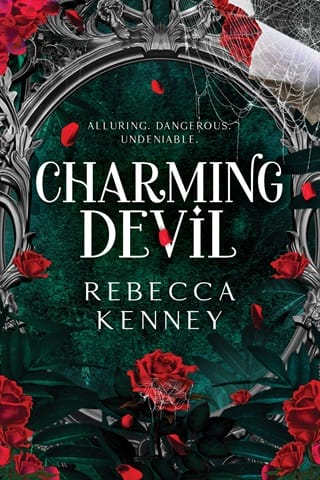
Charming Devil (Gilded Monsters #2)
1 Dorian
1
Dorian
A young man’s naked body is lying on top of me, his long legs threaded with mine.
Rounded joints and soft flesh drape heavily against my chest. His hair tickles my collarbone. He smells like sex and sour wine.
We’re lying on once-white sheets, a canvas painted with the evidence of our sensual excess, while the hand-carved balsa blades of the ceiling fan spin lazily overhead. An energy-efficient fan, Lloyd-Henry said when he recommended it to me. Greener than other ceiling fans. I have no idea if that’s true, but I’ve recently decided I should pay more attention to preserving the earth, since I plan to be on it for quite some time.
I turn my head on the pillow. Beside the bed is a brass table, on which stands a bottle of Dominus Estate and a half-empty glass. I lunge for the glass, but my fingertips skate against its glossy surface, and it falls, tipping rich red wine onto the pale carpet.
“Fuck,” I whisper.
Gently I disentangle myself from the young man and swing my legs off the bed. There is no dizzying tilt of the room, no sudden burst of nausea like I’ve witnessed in others. I barely remember feeling such things. One benefit of my unique existence is the absence of a hangover, no matter how thoroughly I soak my brain in liquor.
A bare-breasted girl lies on the thick rug beside the bed, and more bodies are strewn across the carpet, draped over chairs and sofas, like dissolutes in a Rubens painting—except many of them are pierced, tattooed, their faces daubed with makeup. Some of them sigh or shift positions as I pick my way across the room, snatch a silky robe, and swirl it around my body.
“Dorian,” murmurs a woman. She’s nestled in a huge pillow near the double doors, blinking up at me. Her body is thick, rich, and tempting. But I’m driven by an urge stronger than lust.
I bend, caressing her warm cheek with the backs of my knuckles. “Sleep,” I tell her.
Her lashes drift shut, and I move on, out of the bedroom, down the hall, and up some stairs.
When I bought this house, I had a space created for my most prized possession. I allowed only one craftsman to work on it. He could not leave the house while he created the hiding place, and when he was done, I arranged for him to be transported to the other side of the globe, with enough money to destroy himself thoroughly.
Of all the homes in which I’ve resided and all the hiding places I’ve devised, this one is the cleverest—in the owner’s bathroom, beneath the large, jetted tub, in a hidden space guarded by a panel that looks like part of the elaborate tile mosaic.
The painting is safe. No one knows its location, and only one other person knows of its existence. Yet every morning when I wake up, I must go to see it. It’s a ritual I can’t resist. A daily compulsion.
I have to punch in a code on the keypad first—a code I change frequently and keep only in my head, nowhere else. Then I lean close to the screen to complete the face scan and the optical scan, press two different fingers to the receptors, and speak the password.
The vault opens, and I kneel beside it as gears grind and a waterproof, bulletproof polycarbonate case slides into view, secured with two types of locks. Inside lies my portrait. Its ornate frame is the same one that Basil Hallward gifted to me in 1886.
I pause, taking stock of my emotions. No, I still don’t feel the barest twinge of guilt over Basil’s name.
With a small smile, I inspect the portrait. As usual, everything is the same—
My heart jolts, a thrill of panic shooting through my chest.
Not the same.
I close my eyes. Breathe slowly and deeply, in, then out.
When I look again, my terror increases.
I scuttle backward across the tiled floor, clutching a fistful of silken robe over my heart.
This can’t be happening.
It’s not possible.
I’ve come to accept the changes in the portrait—the effects of my so-called sins, the reflected damage to my body. But this is new.
There is a hole in the lower left corner of the portrait, near the frame. A place where the canvas has dissolved, leaving corroded black edges around a void a little larger than a dime.
Despite all the ways this picture has changed over the years, there has never been a hole , a dissolution of the canvas itself.
It never occurred to me that my painting might reach a maximum capacity, where it could no longer bear the glut of my overindulgence, my wicked apathy, my narcissistic obsession.
But the truth stares me in the face, undeniable. It hollows me out, sets my mind spinning.
There is a point at which my portrait might crumble into nothing.
And when it does— if it does—what will become of me?